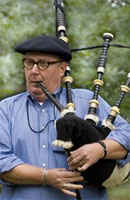|
 |
| Teachers.Net Gazette Vol.5 No.9 | September 2008 |
Subscribe for free home delivery |
|
Our Back Pages The influence of a good story, a heroic character, and the nuances of imaginative language all fly under the radar of standardized testing. Imagination and values are at the heart of what turns the page, at whatever pace. | ||
| by Todd R. Nelson Regular to the Gazette September 1, 2008 |
||
|
 When you see the list of books that inspired these movers and shakers, it makes perfect sense. Al Gore cites Rachel Carson’s Silent Spring. Jane Goodall liked Dr. Doolittle and Tarzan. Bill Gates liked science fiction writers like Isaac Asimov, Arthur Clarke, and Robert Heinlein. Some choices seem more surprising, but still revealing. Even musicians and actors cited books. Bruce Springsteen read Howard Zinn, A People’s History of the U.S. George Clooney liked To Kill a Mockingbird. Meryl Streep chose The Fate of the Earth by Jonathan Schell. Behind each of these great men and women there was a great book that they feel launched them down a path of inquiry, creativity, discovery or work. And everyone recalled the day they heard Sgt. Pepper’s Lonely Hearts Club Band. I sought this phenomenon-in-action with the upcoming generation in our school. Here was Al Gore, for instance, in the Grade 3-4 reading loft. He was using a pseudonym, but I’m pretty sure it was Al—that is, a future environmentalist. It so happens that Jane Goodall was there too, as were Bill Gates and Hollywood actors galore. What were they reading? “Harry Potter One and Three,” said Al. Hmm. The Dark Arts? Wizardry? Will the Harry Potter series be the seminal texts for future politicians, actors, scientists, and Nobel laureates? I also detected gender-based themes in reading. Females tended towards Princess Academy and books on horses; other males were preoccupied with Star Wars and The Titanic. Stereotypes start somewhere. In November, 2007, a New York Times article about the state of reading caught my attention. “The gestation of a true, committed reader is in some ways a magical process, shaped in part by external forces but also by a spark within the imagination,” writes Motoko Rich. “Having parents who read a lot helps, but is no guarantee. Devoted teachers and librarians can also be influential. But despite the proliferation of book groups and literary blogs, reading is ultimately a private act.” The reading loft spars with YouTube. Later in his piece, Rich highlights the pivotal reading moment in the life of two different authors—a moment one could imagine occurring on any given day in any of our homes or classrooms. “In The Child That Books Built, Francis Spufford, a British journalist and critic, writes of how 'the furze of black marks between The Hobbit grew lucid, and released a dragon,' turning him into 'an addict.'" Strange glyphs on the page turn into rich language and spark the young reader’s imagination of how words work. Suddenly reading takes place, and someone has a first book, perhaps a favorite book. Or another phenomenon may be at work: finding yourself in a book. Rich writes: “In accepting the National Book Award for young people’s literature for The Absolutely True Diary of a Part-Time Indian earlier this month, Sherman Alexie thanked Ezra Jack Keats, author of The Snowy Day, a classic picture book. ‘It was the first time I looked at a book and saw a brown, black, beige character—a character who resembled me physically and resembled me spiritually, in all his gorgeous loneliness and splendid isolation.’” Alexie is a Spokane Indian. These experiences make me less concerned by the various mediums, and more concerned with the messages. I hope we’re stocking the souls of children and future vice presidents with scripts that matter in the long run. The influence of a good story, a heroic character, and the nuances of imaginative language all fly under the radar of standardized testing. Imagination and values are at the heart of what turns the page, at whatever pace. And language—meaning, creativity, insight, subtlety—is what creates the movers and shakers we turn out, or turn out to be. A Good Mystery: Why We Read, by Motoko Rich (New York Times, Nov. 25, 2007) | ||
|


 Todd R. Nelson has been a public and private school English teacher and administrator for 29 years, in schools in Cambridge, San Francisco, Chicago and Maine. He is principal at the Adams School in Castine, Maine, a 54 student K-8 school on the town common in a little town on the coast, where he gets to play four-square at recess, play his bagpipes, and write musicals for the all-school play.
Todd R. Nelson has been a public and private school English teacher and administrator for 29 years, in schools in Cambridge, San Francisco, Chicago and Maine. He is principal at the Adams School in Castine, Maine, a 54 student K-8 school on the town common in a little town on the coast, where he gets to play four-square at recess, play his bagpipes, and write musicals for the all-school play.